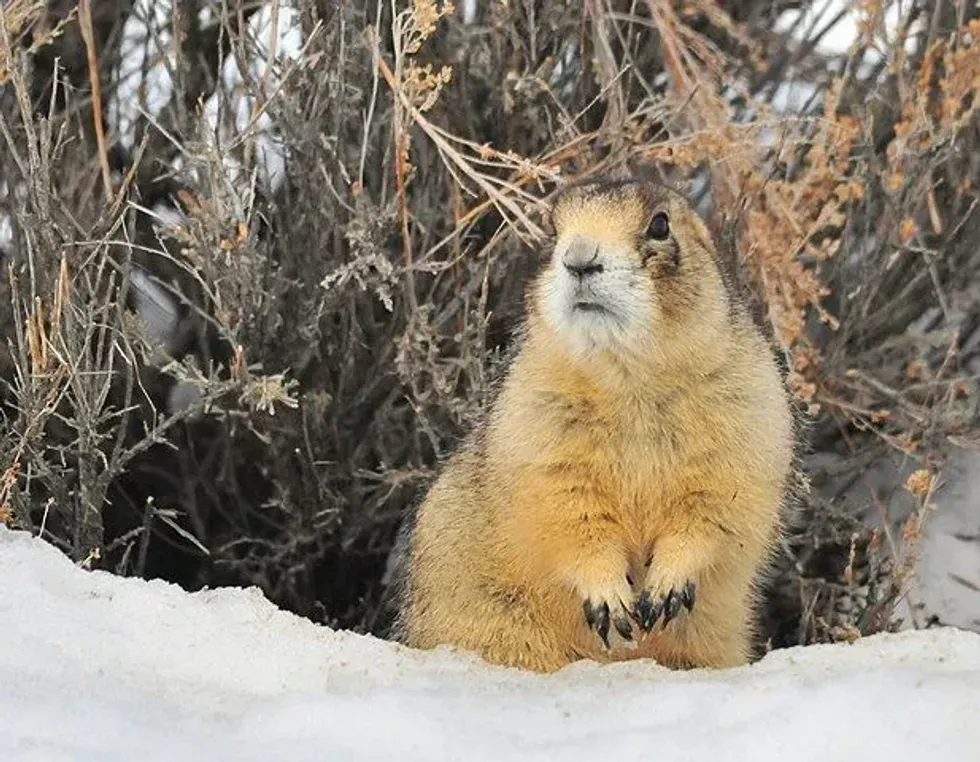Are you fascinated by ground squirrels, like the Xerus? Then here we have all the information on white tailed prairie dogs. The white tailed prairie dog (Cynomys leucurus) is a species of rodent, more specifically a ground squirrel.
These are extremely adorable small animals have are endemic to North America. They are only seen in northeast Utah, Wyoming, Montana, and northwest Colorado in the United States. They live in big colonies that are made up of small familial groups or 'coteries'.
These coteries contain a male, one or more females, and their young pups. Prairie dogs hibernate in the winter.
Their breeding season occurs with their emergence from their hibernation around March to early April. They are small yet fast animals that can become dangerous if they feel threatened by the arrival of predators. They have sharp claws to defend themselves and can also bite.
Read on to learn more about white tailed prairie dogs and if you like this article, then also check out prairie dog facts and black-tailed prairie dog facts.
White-tailed Prairie Dog Interesting Facts
What type of animal is a white tailed-prairie dog?
The white-tailed prairie dog (Cynomys leucurus) is a species of rodent. These prairie dogs are a type of squirrel, or more specifically, a ground squirrel.
What class of animal does a white-tailed prairie dog belong to?
The white-tailed prairie dog belongs to the class Mammalia of animals.
How many white-tailed prairie dogs are there in the world?
The population of the white-tailed prairie dog in an exact number is not known. At least they are not known to be endangered; rather, their population has been seen to be pretty secure within their habitat range. However, the numbers are showing a decreasing trend.
Where does a white-tailed prairie dog live?
These rodents are endemic to North America. Their geographic range is limited to northeast Utah, Wyoming, Montana, and northwest Colorado. This range used to be wider than only this, but many things have led to the decrease in their population numbers and geographic distribution.
What is a white-tailed prairie dog's habitat?
The primary white-tailed prairie dog's habitat is high altitude and dry areas. They are mainly found in dry shrublands and desert grasslands. They have been seen to prefer sage bushes for the purposes of taking cover. These prairie dogs can be found within an elevation of 5000-10000 ft (1524-3048 m).
Who do white-tailed prairie dogs live with?
White-tailed prairie dogs primarily live in colonies. These colonies are made up of family groups. Every colony has at least six different family groups. Unlike other species of prairie dogs, pups of one familial group interact and play with pups from other familial groups.
How long does a white-tailed prairie dog live?
The exact white-tailed prairie dog's lifespan is hard to determine due to these rodents falling victim to predation and human hunting at a major rate. However, in general, male prairie dogs live for five years, and females live for about eight years in the wild.
Those living in captivity can live for much longer if you take care of them properly.
How do they reproduce?
The breeding season of the white-tailed prairie dog occurs around March to early April. Both male and female white-tailed prairie dogs reach sexual maturity at the age of just one-year-old. No courtship behavior exists between the males and the females.
The gestation period is about 30 days. At the end of it, about two to eight pups are born around late April-early May. Only the female cares for the young pups.
Males have been seen to behave pretty aggressively towards the young pups. The females only wean the pups for the first four to five weeks. The newborn pups stay solely in their burrows during this time.
When emerging from the burrows after this time, the mother leaves first to check for predators. The female gives warning calls if she spots a predator. The pups become independent once they leave the burrows.
What is their conservation status?
The conservation status of these prairie dogs, according to the International Union for Conservation of Nature, is listed as Least Concern. However, the population of the prairie dog species is decreasing within their habitat range, owing to poisoning, sylvatic plague, eradication efforts, and conversion of their habitats for urbanization and agricultural purposes.
No conservation actions have been planned or are being taken at this moment.
White-tailed Prairie Dog Fun Facts
What do white-tailed prairie dogs look like?

The white-tailed prairie dog (Cynomys leucurus) is a small prairie dog species. These prairie dogs have an overall light brown-colored fur. Brownish black colored patches can be seen below and above both their eyes. The most distinguishable feature of these prairie dogs, other than their habitat, is their tail, which has a white-colored tip.
How cute are they?
These prairie dogs can be pretty cute. However, they can be pretty aggressive and bite you if they feel threatened in any way. Hence, don't be fooled by their adorable appearance.
How do they communicate?
White-tailed prairie dogs communicate visually, vocally, and by sound. They use body language or visual cues to communicate with others.
Such as, when a group of prairie dogs is eating, if one of them stands up and surveys the area, the others can be seen to do the same.
Research has revealed a total of five different calls. Their call for mild threat is a growl, call for an intense threat is a snarl, their distress call is a scream, alarm call is a repetitive bark, and the group forming call is a laughing bark.
How big is a white-tailed prairie dog?
An adult male white-tailed prairie dog is about 13.5-15.7 in (34.2-39.9 cm) in length, and an adult female is about 12.4-14.8 in (31.5-37.5 cm) in length. These prairie dogs are around the same size as Arctic ground squirrels, who are about 13-19.6 in (33.2-49.5 cm) in length.
How fast can a white-tailed prairie dog run?
These animals may be small, but they can be pretty fast when evading predators. They can run at a speed of 35 mph (56.3 kph) for a short distance.
How much does a white-tailed prairie dog weigh?
A juvenile white-tailed prairie pup weighs about 3.5-5.3 oz (100-150 g) when they emerge for the first time from their burrows about a month after they are born. An adult male weighs about 26.4-60 oz (750-1700 g) on average.
An adult female weighs about 23.8-42.3 oz (675-1200 g) on average. The females weigh less during the breeding season and after lactation. They gain weight during pregnancy, early stage of lactation, and in the summer before they go into hibernation in the fall.
What are the male and female names of the species?
The males and the females of the species have no sex-specific names, but the small family groups that make up the larger colonies are called coteries.
What would you call a baby white-tailed prairie dog?
A baby white-tailed prairie dog is called a pup.
What do they eat?
These prairie dogs are herbivorous in nature. The white-tailed prairie dog's diet mainly consists of various types of grass and sedges.
The pups drink occasionally, and the adults have not been seen drinking water. Hence, it's assumed that they get the water their body requires from the food they eat. They eat enough food in fall, summer, and spring in preparation for their hibernation period in winter.
Would they make a good pet?
Similar to hamsters and other species of rodents, prairie dogs are also becoming a popular choice as pets. They are playful and active in nature. They can become affectionate pets if you keep them from a young age. You will also need to give them a good amount of attention and socialize them from that young age.
Did you know...
White-tailed prairie dogs live in underground burrows. The making of these underground burrows aerates the soil in the area they live in.
In addition, their biological waste fertilizes the soil. This is why usually prairie dog towns have more fertile soil along with better production of sedges and grass, which provides a better grazing area for many other species of animals.
What states do prairie dogs live in?
There are a total of five species of prairie dogs. Four of these five species live in the United States. The black-tailed prairie dog lives in the dry plains from Canada to Central Texas.
The white-tailed prairie dog lives in Utah, Wyoming, Montana, and northwest Colorado. Gunnison's prairie dog lives in northeastern Arizona, southwestern Colorado, northwestern New Mexico, and southeastern Utah. The Utah prairie dog lives only in Utah.
Black-tailed prairie dog vs. white-tailed prairie dog
There are a few conspicuous differences between the species of black-tailed and white-tailed prairie dogs. Black-tailed prairie dogs have a black-tipped tail, while the white-tailed prairie dogs have a white-tipped tail.
The geographic range of the black-tailed prairie dogs is much more widespread than the white-tailed prairie dog range. White-tailed prairie dogs occur in higher elevated areas than black-tailed prairie dogs.
Here at Kidadl, we have carefully created lots of interesting family-friendly animal facts for everyone to discover! Learn more about some other mammals from our garden dormouse facts and gopher facts pages.
You can even occupy yourself at home by coloring in one of our free printable squirrel coloring pages.
Main image by USFWS.
Second image by USFWS.









